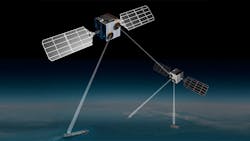Phased-Array Antennas Take on Space-Payload Duties
ThinKom Solutions has developed a new family of phased-array antennas for deployment on satellites and other space vehicles. The antennas, which are based on ThinKom’s Variable Inclination Continuous Transverse Stub (VICTS ) technology, are multi-frequency, full-duplex antennas for operation on geostationary and non-geostationary satellites using the C-, X-, Ku-, Ka-, Q-, V-, E-, and W-bands. They can provide steerable high-capacity inter-satellite links as well as space-to-earth and earth-to-space feeder and user links.
The ThinKom payload antennas are compact and lightweight, with a 30-cm diameter antenna weighing less than 5 kg. They can be nested for multi-beam applications without the blockages that can occur with multiple parabolic dish arrays. They can also support digital beam forming within regional user beams.
The space-payload VICTS antennas comprise an aluminum structure and space-compatible components to function reliably under extreme conditions of radiation, shock, vibration, and temperature. The compact, highly reliable conformal arrays require no post-launch deployment mechanisms, eliminating the added weight and complexity of traditional satellite antenna systems.
The high-efficiency VICTS antenna architecture enables a smaller mounting size and volume for a given level of performance, as well as lower inertia than traditional satellite designs. The result is extremely low power consumption, a critical requirement for space applications.
Other key features include 80° scan angle coverage; wide instantaneous channel bandwidth of up to 2 GHz; polarization diversity; low sidelobe emissions; and continuous, jitterless high-agility scanning.
According to Bill Milroy, CTO and chairman of ThinKom Solutions, “Our space-payload antennas hit the ‘sweet spot’ between bulkier and heavier gimbaled dish antennas, with their deployment and kinematic complexities, and the less efficient and power-hungry electronically steered arrays (ESAs).” Milroy added, “A 30-cm VICTS antenna requires a small fraction of the power and area required for a comparably performing ESA.”
About the Author
David Maliniak
Executive Editor, Microwaves & RF
I am Executive Editor of Microwaves & RF, an all-digital publication that broadly covers all aspects of wireless communications. More particularly, we're keeping a close eye on technologies in the consumer-oriented 5G, 6G, IoT, M2M, and V2X markets, in which much of the wireless market's growth will occur in this decade and beyond. I work with a great team of editors to provide engineers, developers, and technical managers with interesting and useful articles and videos on a regular basis. Check out our free newsletters to see the latest content.
You can send press releases for new products for possible coverage on the website. I am also interested in receiving contributed articles for publishing on our website. Use our contributor's packet, in which you'll find an article template and lots more useful information on how to properly prepare content for us, and send to me along with a signed release form.
About me:
In his long career in the B2B electronics-industry media, David Maliniak has held editorial roles as both generalist and specialist. As Components Editor and, later, as Editor in Chief of EE Product News, David gained breadth of experience in covering the industry at large. In serving as EDA/Test and Measurement Technology Editor at Electronic Design, he developed deep insight into those complex areas of technology. Most recently, David worked in technical marketing communications at Teledyne LeCroy, leaving to rejoin the EOEM B2B publishing world in January 2020. David earned a B.A. in journalism at New York University.

